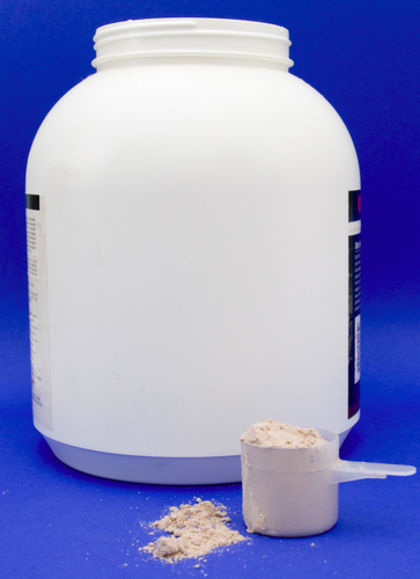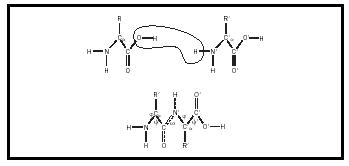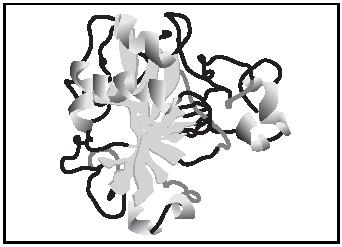Proteins

Excluding the water present in the human body, about one half of the remaining mass is composed of a class of molecules called proteins. It should therefore be of no surprise that proteins carry out many important biological processes.
Amino Acids
Proteins are essentially natural polymers composed of long chains of subunits. These smaller units are called amino acids. One "end" of an amino acid has acidic character because it has a carboxyl (COOH) functional group . The other end has basic character because it has an amino (NH 2 ) functional group. When two amino acids react, they form what is called a peptide bond. The resulting molecule, called a dipeptide, still has one end that is acidic and another that is basic (Figure 1). With this fundamental reactive pattern, it is possible to string together many amino acids to form a polypeptide . For such a chain, the end that has the carboxyl group is referred to as the C-terminus; the amino end is referred to as the N-terminus.
Some proteins, including a number of hormones, have only a relatively small number of amino acid units, while others have literally thousands. Once an amino acid is incorporated into the polypeptide, it is referred to as a residue. When biochemists identify a particular portion of a protein, they usually refer to the residue with its name and a number, referring to how far from the N-terminus that residue is located.
In the human body, there are twenty different amino acids that are found in proteins ✶ . The body is capable of synthesizing most of the amino acids it needs, but there are eight molecules that cannot be made. These are called
✶ See table of amino acids in the Amino Acids article.

the essential amino acids, and they must be present in the diet or a person will develop malnutrition. Many people gain the amino acids they need by eating a diet that contains complete proteins. Most meats (such as beef, poultry, or fish) have complete proteins. The body metabolizes (breaks down) these ingested proteins and in so doing provides the raw materials needed for making the proteins.
People who do not eat meat must be careful to eat a diet that includes the essential amino acids. This can be accomplished by eating complementary proteins. For example, corn has many essential amino acids but is low in tryptophan. Beans, however, have ample tryptophan; cultures that use cornmeal often complement this food source with beans. Similarly, cultures in Asia often eat rice with soy sauce; this combination provides complementary proteins in the diet.
Protein Structure
The order of the amino acids in a protein dictates the primary structure of the protein. While other levels of structure are important, they all follow from the order of the residues. The primary structure is dictated by genetic information found in a cell; deoxyribonucleic acid ( DNA ) contains the code that directs which amino acids are linked together. The processes by which the genetic code is read and proteins are synthesized are called transcription and translation.
The next level of protein structure is called the secondary structure. The side chains of the residues have various functional groups that can have different types of forces: some are hydrophobic and others are hydrophilic ; some participate in hydrogen bonding interactions while others do not. These forces lead to conformations (geometric arrangements of the residues) that result in lower energies. Two specific arrangements that are found regularly are shown in Figure 2: a helix (which looks like a corkscrew) and a pleated sheet (which looks like a paper that has been folded and opened).
The secondary structure of the protein is the result of interactions of side chains that are located within a few residues of each other. Proteins are sufficiently long that they can eventually fold back on themselves, allowing residues that are farther apart in the primary structure to interact with each other. These interactions give rise to the tertiary structure of the protein

(Figure 2). Some proteins can form structures with multiple units (dimers, trimers, or tetramers). These collections of units provide yet another level of structure called the quaternary structure.
Solubility is one property that can be used to classify the proteins that result from the various levels of structure. For example, fibrous proteins are not soluble in water. Many familiar components of tissues are composed of fibrous proteins, including keratin (the protein present in hair), collagen (a structural protein found in tendons and cartilage), myosin (a protein found in most muscle tissue), and fibrin (the protein that allows blood to clot and form scabs). Conversely, globular proteins are soluble in water. For example, albumins are water-soluble proteins that provide a familiar example of what happens when a protein loses its secondary and tertiary structure, a process called denaturation. When an egg is cooked, the egg white changes from translucent to white; this color change is indicative of the change in structure that has taken place in the albumin proteins.
In many cases, the structure of a protein defines a key location called the active site, the region that is associated with the primary activity of a protein, even though it is often made up of only a small number of residues.
Biological Functions
The variety of structures associated with proteins suggests the large number of biological tasks that they carry out. It is possible to classify proteins based on their biological functions.
Enzymes are proteins that catalyze chemical reactions that take place in living systems. A catalyst is a molecule that speeds up a reaction but is not consumed by that reaction. Enzymes are particularly interesting because they often are quite specific, capable of catalyzing only one type of biochemical reaction. Learning about the structure of the active site is often a crucial component of studies that look at the catalytic properties of an enzyme.
Many hormones are proteins, often containing only a relatively small number of residues. Insulin is perhaps the most well known peptide hormone; because of its role in the metabolism of carbohydrates, it plays an important role in the control of diabetes. Growth hormone is another example of a protein.
Some neurotransmitters are closely related to proteins, differing from them only because they have relatively few residues. There are many known neurotransmitters; endorphins and enkephalins are examples of peptides that carry out this role.
Many antibodies and other components of the immune response system are proteins. One important component of a body's defenses is the ability to form clots to stop bleeding from cuts. A protein called fibrinogen plays a key role in this.
Proteins comprise a majority of muscle tissue. Two classes of protein, actin (which makes moving filaments) and myosin (which remains stationary), are primary components of the muscles in the body.
Proteins are often involved in the storage of nutrients in the body. For example, iron is stored (mostly in the spleen) in a protein called ferritin. In plants, nutrients needed for the growth of a new plant are a major component of seeds, and storage proteins carry out this task.
In addition to storing nutrients, proteins can transport them. Perhaps the most critical transport protein is hemoglobin, which transports oxygen and carbon dioxide in the bloodstream. In the lungs the percentage of oxygen is high, so it binds to the protein in an equilibrium process. When hemoglobin reaches tissue that has produced carbon dioxide, the oxygen is released and used by cells in metabolism. The hemoglobin can then bind carbon dioxide and carry it to the lungs to be released.
There are several ways that proteins contribute to the structure of living things. Glycoproteins play a major role in the structures of cell membranes. While lipids are more numerous in the membrane, many of the key functions that occur at the membrane level, such as transport of materials, are carried out by transmembrane proteins. Receptors , including those in nerve cells, are proteins that help cells interact with their external environment. Some tissues like cartilage have proteins that help provide structure on a larger scale.
Proteins can also be dangerous or unhealthy. For many who suffer from allergies to agents like pollen, it is proteins on the surface of the pollen that cause an immune response that triggers the allergic reaction. More seriously, many natural toxins are proteins. Snake venom is one example of a naturally occurring protein-based toxin.
CARBON MONOXIDE POISONING
Carbon monoxide, CO, poisons the body by combining with hemoglobin some 250 times more tightly than O 2 , thus hindering the transport of O 2 to the body's tissues. In an environment of 0.1 percent CO (within the lung), more than half the binding sites of hemoglobin become occupied with CO, and the victim dies within an hour.
—N. M. Senozan
SEE ALSO Active Site ; Amino Acid ; Denaturation ; Enzymes ; Fibrous Proteins ; Globular Proteins ; Neurotransmitters ; Peptide Bond ; Protein Solubility ; Protein Synthesis ; Protein Translation ; Rna Synthesis ; Secondary Structure ; Tertiary Structure ; Transmembrane Proteins ; Venom .
Thomas A. Holme
Bibliography
Branden, C., and Tooze, J. (1999). Introduction to Protein Structure, 2nd edition. New York: Garland Publishing.
Creighton, T. E. (1993). Proteins, 2nd edition. New York: Freeman.
Davies, J. S., ed. (1985). Amino Acids and Peptides. New York: Chapman & Hall.
Lesk, A. M. (2000). Introduction to Protein Architecture: The Structural Biology of Proteins. Oxford: Oxford University Press.
Voet, D., and Voet, J. G. (1995). Biochemistry , 2nd edition. New York: Wiley.